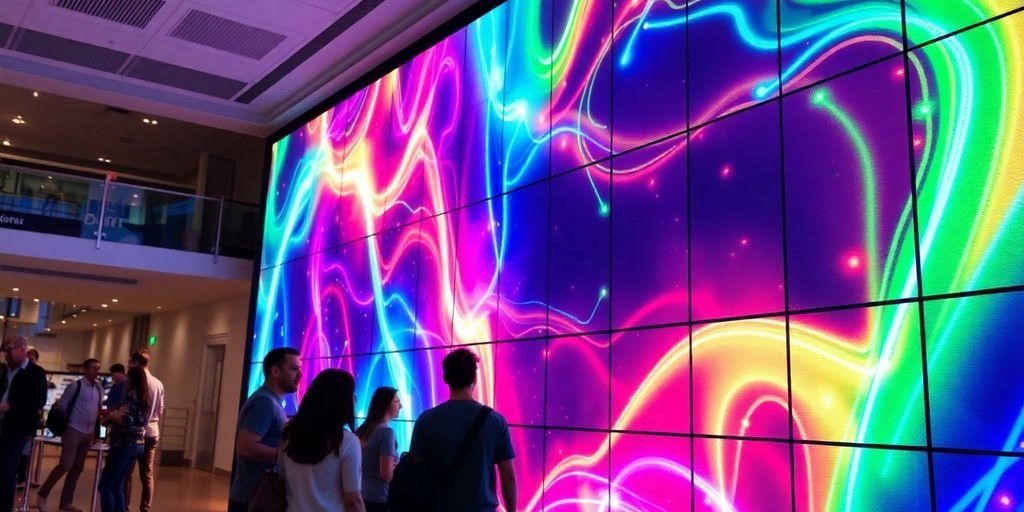
LED Wall Displays are changing how we experience visuals. They're everywhere, from advertising to entertainment. Let's explore what makes them so popular.
These displays offer brightness and clarity. They grab attention in ways traditional screens can't. The impact of a well-placed LED Wall Display is undeniable.
They are versatile and adaptable. They can fit any space, big or small. The technology is constantly improving, making them a smart investment.
High-Quality Visuals and Brightness
LED Wall Displays deliver superior image quality. They offer vibrant colors and high contrast. This makes content pop, even in bright environments.
Brightness is a key advantage. They can be seen clearly in direct sunlight. This is crucial for outdoor advertising and events.
They use light-emitting diodes. These diodes create a brighter, clearer picture. This results in a more engaging viewing experience.
Versatility in Applications
LED Wall Displays are incredibly versatile. They can be used in many different settings. From retail stores to concert venues, they fit right in.
They can be customized to any size or shape. This allows for creative and unique installations. The possibilities are almost endless.
LED Wall Displays can transform any space. They can create immersive experiences. This makes them a great choice for businesses and organizations.
Energy Efficiency and Cost Savings
LED technology is energy-efficient. This means lower electricity bills. Over time, this can lead to significant cost savings.
They also have a long lifespan. This reduces the need for frequent replacements. This saves money and reduces waste.
Compared to older display technologies, LEDs are a clear winner. They are better for the environment and your wallet.
What is an LED Wall Display?
So, what is an LED wall display anyway? You see them everywhere these days, but it's good to understand what they are. Basically, it's a big screen made up of lots of little LEDs (light-emitting diodes). These LEDs work together to show images, videos, and all sorts of content.
Think of it like a giant TV, but way more flexible. LED wall displays can be shaped and sized to fit almost any space. They're super bright and clear, which makes them great for catching people's attention.
These displays are used in all kinds of places. From advertising billboards to concert stages, they're a popular choice for getting a message across. An LED wall display is a versatile tool for visual communication.
Indoor vs. Outdoor LED Displays
Indoor LED displays are designed for controlled environments. They usually have a tighter pixel pitch, meaning the LEDs are closer together. This gives a sharper image when you're up close.
Outdoor LED displays need to be tougher. They have to withstand weather like rain, sun, and wind. These displays often have a wider pixel pitch because they're viewed from farther away.
Brightness is also a big difference. Outdoor displays need to be much brighter to compete with sunlight. Indoor displays can be dimmer and still look great.
Modular LED Displays
Modular LED displays are built from individual panels or tiles. These panels can be connected to create a screen of any size or shape. This makes them really adaptable to different spaces.
One of the cool things about modular displays is that they're easy to repair. If one panel goes bad, you can just replace that one panel instead of the whole display. This can save a lot of money in the long run.
Modular designs also make installation easier. The panels are lightweight and easy to handle, so you can set up a big display without too much trouble.
Key Benefits of LED Wall Displays
High-Quality Visuals and Brightness
LED wall displays are known for their superior image quality. They deliver bright, vibrant colors and sharp details. This makes them ideal for environments where visual impact is important. Think about how much more engaging a presentation is with a clear, bright display.
They also offer excellent contrast ratios. This means deeper blacks and brighter whites. The result is a more realistic and immersive viewing experience.
These displays maintain image quality even in brightly lit spaces. This is a huge advantage over traditional projection systems.
Versatility in Applications
LED wall displays can be used in many different settings. From retail stores to corporate lobbies, they fit almost anywhere. Their modular design allows for customization to fit specific needs.
They can be configured into various shapes and sizes. This flexibility makes them perfect for creative installations. Imagine a curved display in a museum or a massive screen at a concert.
LED walls are great for advertising, information sharing, and entertainment. They can adapt to any environment, making them a smart investment.
Energy Efficiency and Cost Savings
LED technology is inherently energy-efficient. This translates to lower operating costs over time. Compared to older display technologies, LED walls consume significantly less power.
LEDs have a long lifespan, reducing the need for frequent replacements. This also minimizes maintenance costs. The initial investment pays off in the long run.
Choosing an LED wall display is a sustainable choice. It reduces your carbon footprint while saving you money. It's a win-win for your business and the environment.
Different Types of LED Wall Displays
There's a bunch of LED wall display options out there. It really boils down to where you're planning to use it and how flexible you need it to be. Let's break down the main types.
Indoor vs. Outdoor LED Displays
Indoor and outdoor LED wall displays aren't the same thing. Obvious, right? But the differences are important.
Outdoor displays need to be way tougher. They have to handle rain, sun, and all sorts of weather. Indoor ones? Not so much. Brightness is also a big deal. Outdoor displays need to be super bright to be seen in sunlight. Indoor ones can be dimmer.
Modular LED Displays
Modular LED displays are like building blocks. You can put them together to make any size or shape you want. Pretty cool, huh?
This makes them super flexible. Need a giant screen for a concert? No problem. Want a weirdly shaped display for an art installation? You got it. They're easy to customize.
Modular displays are great because you can swap out individual panels if one breaks. No need to replace the whole thing. That saves money and hassle.
How to Choose the Right LED Wall Display
Choosing the right LED wall display can feel overwhelming. There are many factors to consider, but breaking it down makes the process easier. Think about your specific needs and environment.
Consider the viewing distance. Also, think about the content you plan to display. These factors will guide your decision.
Don't rush the process. Take your time to evaluate your options. A well-chosen LED wall display can transform your space.
Installation and Maintenance Considerations
Planning for LED wall display installation and upkeep is key. It helps ensure long-term performance and minimizes disruptions. Let's look at what's involved.
Pre-Installation Planning
Before you even think about mounting anything, plan. Assess the site. Consider viewing angles, ambient light, and structural support.
- Check power availability.
- Plan cable runs.
- Confirm structural integrity.
Professional Installation
Don't DIY this. LED wall displays need pros. They have the tools and know-how for proper setup.
- Alignment is critical.
- Calibration is a must.
- Safety first.
Routine Maintenance
Keep your display looking its best. Regular checks prevent big problems later. Think of it like changing the oil in your car.
Regular cleaning, inspections, and timely repairs are important. This keeps the display working well and looking good.
Troubleshooting Common Issues
Things go wrong. Be ready to fix them. Know the common problems and how to address them.
- Dead pixels happen.
- Color shifts can occur.
- Connectivity issues arise.
Long-Term Care
Extend the life of your LED wall display. Follow best practices for operation and storage. This will save money in the long run.
- Control brightness levels.
- Manage heat effectively.
- Use surge protectors.
Future Trends in LED Wall Display Technology
Enhanced Resolution and Pixel Pitch
Expect LED wall display resolution to keep climbing. Smaller pixel pitches mean sharper images, even up close. This is a game-changer for detailed content.
Think about the possibilities! Imagine crystal-clear visuals, no matter how close you are. It's all about making the viewing experience better.
This will make LED displays even more appealing for a wider range of applications.
Flexible and Transparent Displays
Flexible displays are becoming a reality. They can conform to curved surfaces, opening up new design options. Transparent LED wall display tech is also on the rise.
Imagine displays that blend seamlessly into architecture. It's not just about screens anymore; it's about integration. This tech could change how we interact with our environment.
Flexible and transparent displays are set to revolutionize how and where we use digital signage.
AI and Smart Integration
AI is making LED displays smarter. Expect features like automatic brightness adjustment and content optimization. Smart integration will streamline content management.
AI can analyze viewing habits and tailor content accordingly. This means more engaging and effective displays. It's all about delivering the right message at the right time.
This will make LED displays more user-friendly and efficient.
Conclusion: Transforming Spaces with LED Wall Displays
LED wall displays have really changed how we experience visual content. They're not just screens; they're tools that can transform spaces and captivate audiences. From retail environments to corporate lobbies, the impact is undeniable.
These displays offer unmatched versatility and visual quality. They grab attention and leave a lasting impression. It's about creating immersive experiences that stick with people.
The future is bright for LED wall display technology. As technology advances, we can expect even more innovative applications and enhanced visual experiences. The possibilities are endless, and the impact will only continue to grow.
Wrapping Up the Benefits of LED Wall Displays
In conclusion, LED wall displays are changing the game when it comes to visual experiences. They provide bright, clear images that grab attention, whether in a store, at an event, or in a corporate setting. These displays are not just about looks; they also help brands tell their stories and connect with audiences in a memorable way. Plus, with their long lifespan and low maintenance needs, they’re a smart investment for any business. As technology keeps advancing, it’s clear that LED wall displays will continue to play a big role in how we engage with visuals in our everyday lives.



